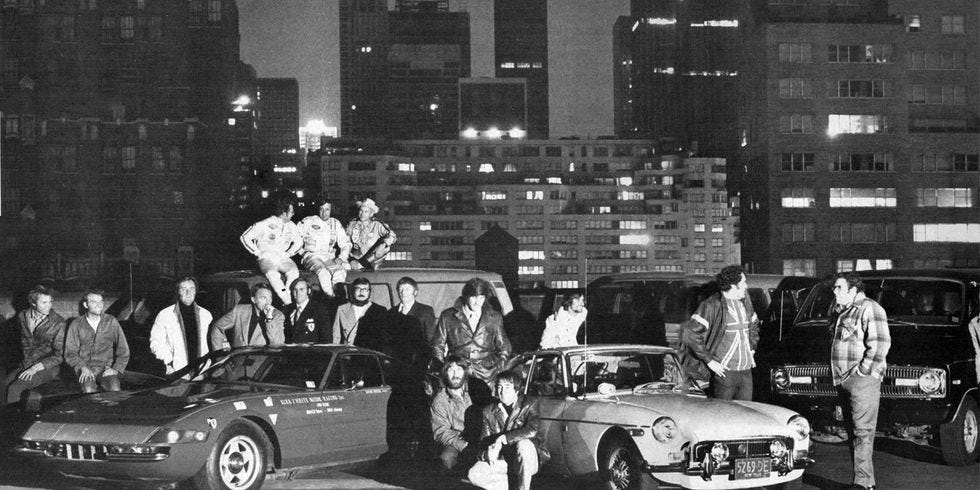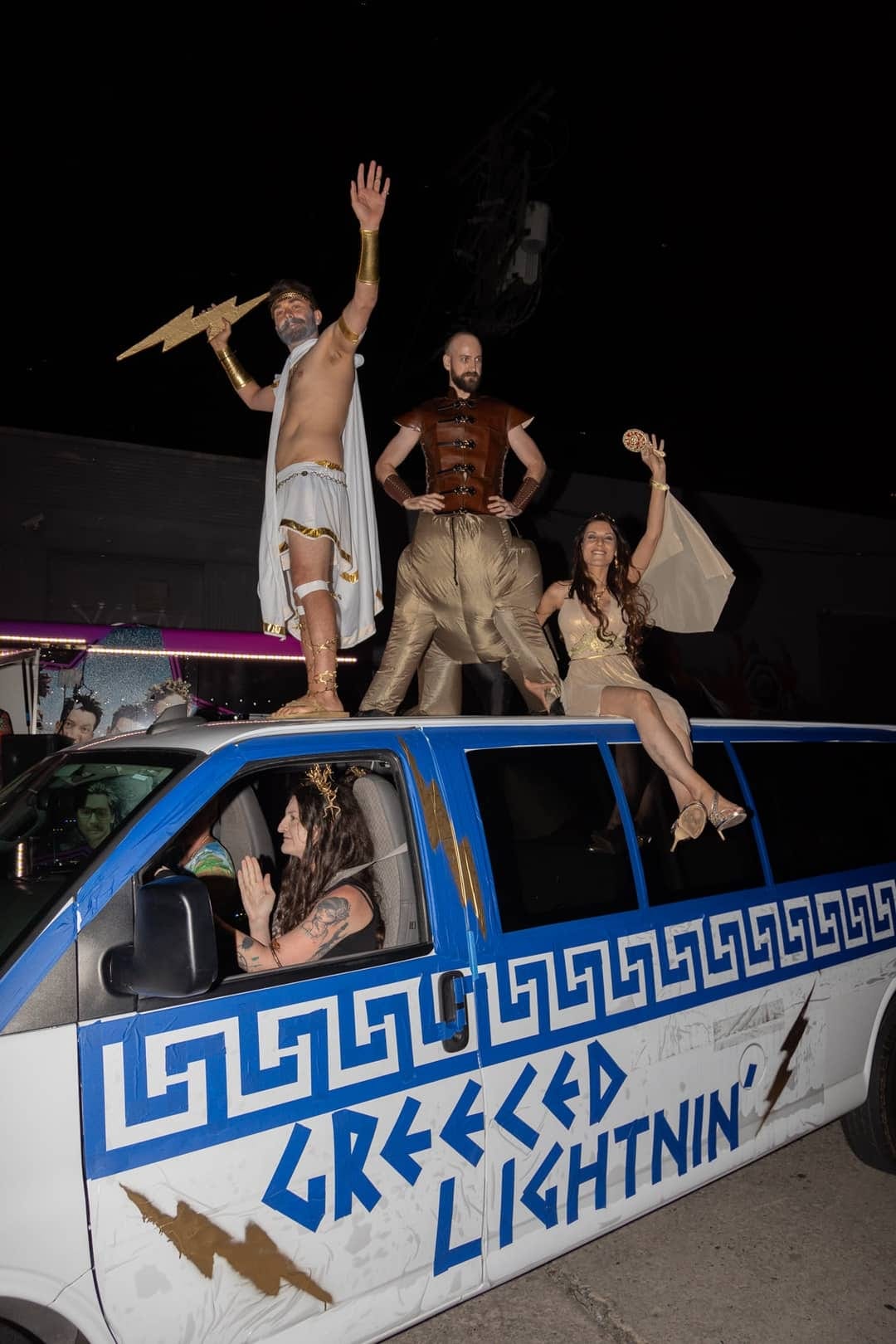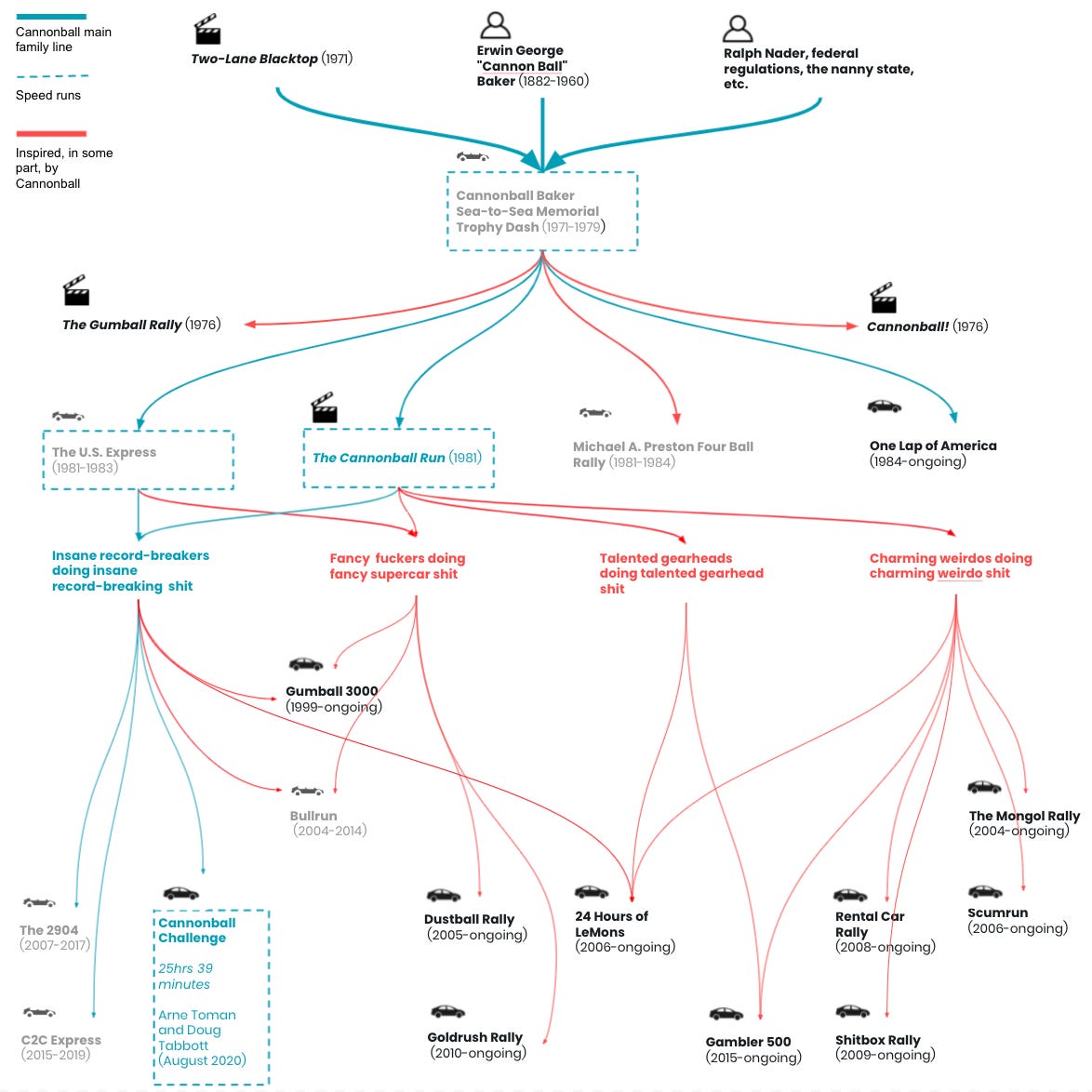Steve Bryant (SB) is a content strategy and ops consultant, co-founder of the midnight costumed adventure Rental Car Rally, founding editor of InsideHook, triangle enthusiast, and a longtime friend of WITI (he wrote our very first guest edition on Maslow and recent editions on Jeeps and cross-country road trips).
Steve here. Back in the 1970s, several states began mandating 55mph speed limits on highways. This was the time of the energy crisis, and the new limit was intended to reduce the consumption of fuel. Congress followed suit in 1974 with the first-ever national speed limit of 55mph. Drivers everywhere called this new mandate the “double nickel”. It saved a little fuel. It saved a lotta lives. But drivers wanted to go fast, so nobody liked it all that much.
The journalist Brock Yates liked it least of all. Yates detested state regulations. Yates detested federal regulations. And Yates had long argued, in his articles for Car and Driver, that safe driving was possible at almost any speed.
To prove his point, Yates and former Car and Driver editor Steve Smith created a race. The starting line would be the Red Ball Garage in Manhattan, where Car and Driver housed its test fleet. The finish line would be the Portofino Hotel in Redondo Beach, a renowned racers’ hangout. The only goal was to get across the country as fast as possible. The only rule was that there were no rules. Yates called the race The Cannonball Baker Sea-to-Shining Sea Memorial Trophy Dash—“a balls-out, shoot-the-moon, fuck-the-establishment rumble … to prove … that good drivers in good automobiles could employ the American Interstate system the same way the Germans were using their autobahns”.
Today, thanks to the 1981 movie starring Burt Reynolds (written by Yates), that race is largely remembered as The Cannonball Run. Across the four races, from 1971 to 1979, there were never any injuries. There were never any deaths. There was a team dressed as paramedics in an ambulance. A team dressed as government officials tracking radiation leaks. A team dressed as priests belonging to an ecumenical council of prelates in California—all to confound highway patrolmen on the watch for speeding motorists.
The fastest time: 32 hours 51 minutes, running an average of 87mph, set in 1979 by a team driving a Jaguar XJS. “Truth and Justice,” Yates wrote, “affirmed by an overtly illegal act”.
The Cannonball wasn’t the first transcontinental race. But it was the first anti-establishment transcontinental race. And it was the first transcontinental race to be driven by competitors in disguise. Thanks to that brand of chaotic goofiness, the Cannonball is the spiritual ancestor of races and rallies today that seek, in the pursuit of glory and ignominy alike, to poke a finger in the eye of prudes and police everywhere.
The six vehicles and 16 drivers of the original 1971 Cannonball, as they appeared in the March 1972 issue of Car and Driver
Why is this interesting?
This November marks the 50th anniversary of the first Cannonball. In the intervening 50 years, cars changed. Car culture changed. Brock Yates changed. He declined to continue the Cannonball in 1980 after visiting a friend and amateur driver who planned to race the next event in a Lamborghini Countach. Too dangerous, Yates said. And so that was that. He passed in 2016 and is known today, by at least one previous transcontinental record holder, as the most important man in American car culture who never ran a car company.
But since that time, at least two separate but connected trends have emerged. One, the speed-running ethos of Cannonball evolved into unsanctioned, individual efforts to break the Cannonball record. Two, the Cannonballs’ nonsense and non-sensibility have survived within a variety of highly goofy moto-vents.
On the trend of speed runs: The U.S. Express attracted drivers for several years in the ‘80s (including Sims designer Will Wright). The cops caught wind, it closed shop. There were Cannonball-style attempts in Europe. Several people were arrested. There were Cannonball-style attempts in Australia. Several people died. Yates himself founded a “kinder, gentler successor to Cannonball” called One Lap of America but, after finger-wagging from Ralph Nader (among others) that evolved into an untimed, long-distance endurance rally and series of closed-circuit time trials. Few public attempts, it seems, continued to be made at the speed record.
That was until three drivers in a BMW M5 set a transcontinental record of 31 hours 4 minutes running from the Classic Car Club NYC to Santa Monica Pier. Shortly after that, a cross-country race called The 2904 launched and ran for ten years. Likewise, the C2C Express, which ran from 2015 to 2019, in which one team managed to set a transcontinental speed record. That record has since been eclipsed multiple times. The current record was set last year at 25hrs 39 minutes.
As for the goofiness: there’s a surfeit. We live in a golden age of drivers who enjoy dressing in costume to perform feats of motoring gibberish. Most of these events are not races, and certainly not transcontinental. But each is inspired, at least in some part, by the Cannonball.
I have some small perspective here. Since 2008 I’ve organized, along with my partners Franz Aliquo and Yutai Liao, a driving challenge called Rental Car Rally: a 24-hour, midnight-to-midnight traveling carnival where 50+ costumed teams travel 500 miles visiting curiously odd attractions. It’s not a race, but it is a questionably legal and unquestionably stupid endurance drive, and for that, we consider ourselves distant, moronic cousins to the original memorial trophy dash.
Greece Lightnin’, a competing team in Rental Car Rally 2021
There are many, many others. The closed-circuit, costumed shitcar race 24 Hours of Lemons. The off-roading, hard-partying Gambler 500. There’s Gumball 3000 for long-distance rallies in super cars. The Mongol Rally for adventuring across Eurasia. And no end of fancy car rallies, from The Goldrush to The Dustball.
A delightfully modded school...bustruck?... in the Gambler 500
Each of these events hails from a different part of car culture, but all of them carry some small, vestigial sequence of Yatesian DNA.
So for your flowchart-y pleasure, here’s a somewhat arbitrary and entirely incomplete visualization of the world the Cannonball created. It is in no way comprehensive and especially not inclusive of influences like the English road rallying tradition, sanctioned American motorsports, or Vin Diesel. You can tell I’m a serious designer because I made it in PowerPoint.
Drive safe and stay weird out there. (SB)
Steve’s visualization of the day:
Quick Links:
On the secret workday power nap. (CJN)
A Times deep dive on Putin’s Russia (CJN)
An iconic NYC lunch (CJN)
Thanks for reading,
Noah (NRB) & Colin (CJN) & Steve (SB)
—
Why is this interesting? is a daily email from Noah Brier & Colin Nagy (and friends!) about interesting things. If you’ve enjoyed this edition, please consider forwarding it to a friend. If you’re reading it for the first time, consider subscribing (it’s free!).







